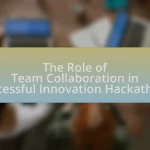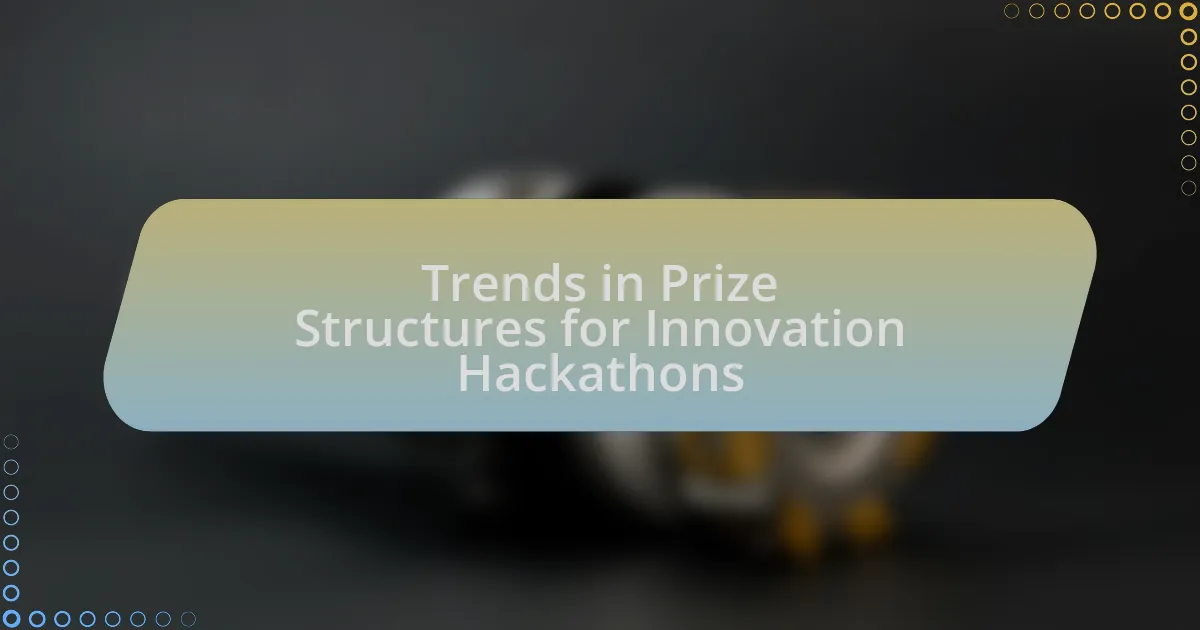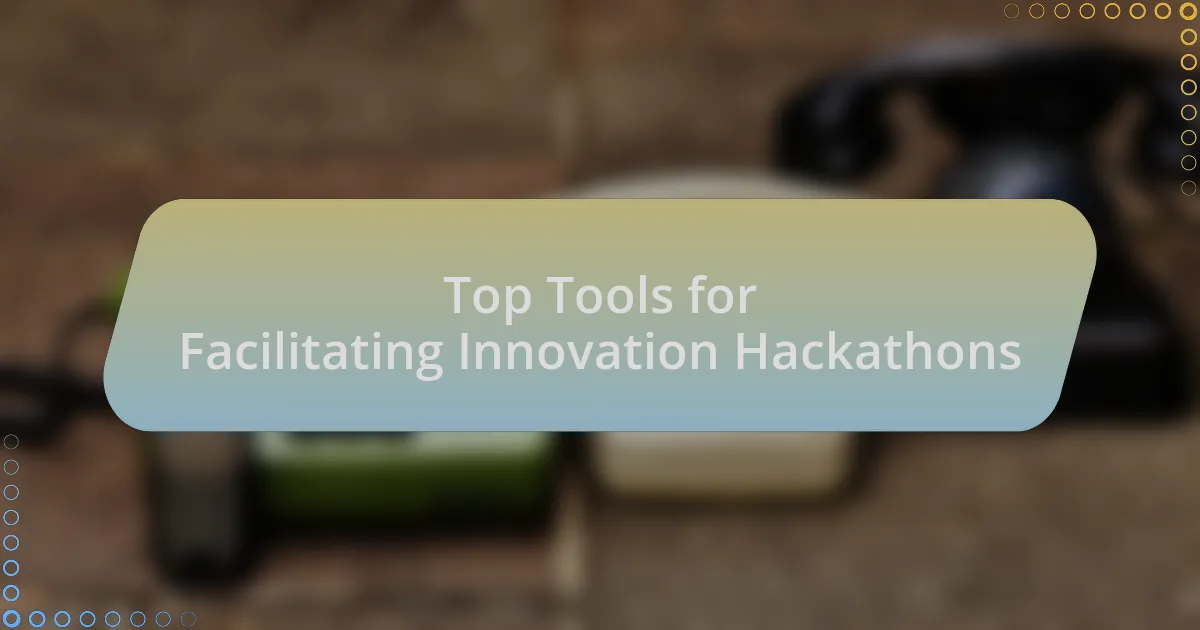The article focuses on successful innovations that have emerged from hackathons, which are collaborative events where participants develop projects within a limited timeframe. It explores the purpose of hackathons in fostering creativity and teamwork, highlighting how they lead to innovative solutions and products, such as GroupMe and Venmo. The article also discusses the importance of diverse teams, mentorship, and structured objectives in enhancing the outcomes of hackathons, as well as the challenges faced during development. Additionally, it examines future trends in hackathons, including remote participation and the integration of technology, emphasizing their role in driving advancements in various fields.
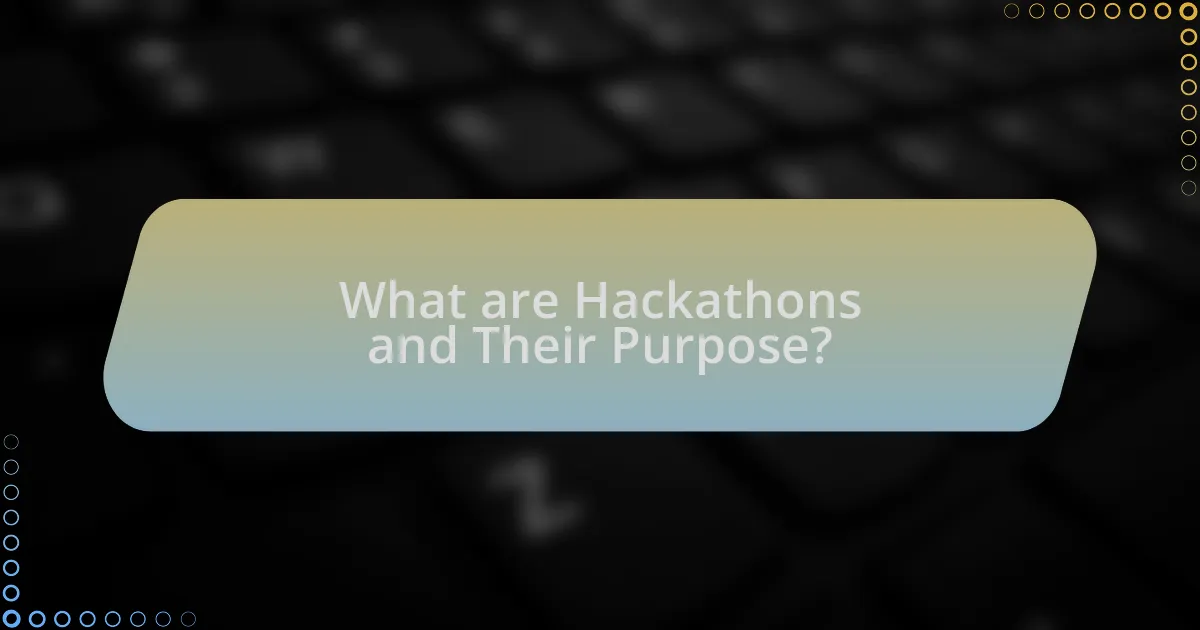
What are Hackathons and Their Purpose?
Hackathons are intensive collaborative events where individuals, typically software developers, designers, and entrepreneurs, come together to create innovative projects within a limited timeframe, usually ranging from 24 to 48 hours. The primary purpose of hackathons is to foster creativity, encourage teamwork, and accelerate the development of new ideas or solutions, often resulting in prototypes or minimum viable products. These events serve as a platform for participants to network, learn new skills, and showcase their talents, while also addressing specific challenges or themes set by the organizers. Hackathons have led to the creation of successful products and services, such as Twitter and GroupMe, demonstrating their effectiveness in driving innovation and entrepreneurship.
How do Hackathons Foster Innovation?
Hackathons foster innovation by creating an intense, collaborative environment that encourages rapid problem-solving and creativity. During these events, diverse teams come together to brainstorm and develop prototypes within a limited timeframe, often leading to unique solutions that might not emerge in traditional settings. For instance, the development of the popular messaging app GroupMe originated from a hackathon, demonstrating how such events can catalyze innovative ideas into viable products. Additionally, research from the Harvard Business Review indicates that hackathons can significantly enhance team dynamics and creativity, as participants are motivated by competition and the opportunity to showcase their skills.
What types of projects are typically developed during Hackathons?
Hackathons typically develop projects that focus on software applications, hardware innovations, and solutions addressing specific social issues. These projects often include mobile apps, web platforms, data analysis tools, and prototypes for new technologies. For instance, many hackathons encourage participants to create solutions for healthcare, education, and environmental challenges, reflecting a trend towards socially impactful innovations. According to a study by the University of California, Berkeley, 70% of hackathon projects aim to solve real-world problems, demonstrating the alignment of hackathon outputs with societal needs.
How do participants collaborate to create innovative solutions?
Participants collaborate to create innovative solutions by engaging in structured teamwork, sharing diverse perspectives, and leveraging collective skills during hackathons. This collaborative environment fosters creativity and accelerates problem-solving, as participants brainstorm ideas, prototype solutions, and iterate based on feedback. Research indicates that diverse teams are more effective in generating innovative outcomes; for instance, a study by Page (2007) in “The Difference: How the Power of Diversity Creates Better Groups, Firms, Schools, and Societies” demonstrates that groups with varied backgrounds produce more creative solutions than homogenous teams. Thus, the combination of teamwork, diversity, and iterative processes in hackathons leads to successful innovations.
Why are Hackathons Important for Startups and Corporations?
Hackathons are important for startups and corporations because they foster innovation, collaboration, and rapid problem-solving. These events bring together diverse teams to generate creative solutions in a short timeframe, often leading to the development of new products or features. For instance, companies like Facebook and Spotify have utilized hackathons to create significant features, such as the “Like” button and Spotify’s Discover Weekly playlist, respectively. This collaborative environment not only accelerates the ideation process but also enhances team cohesion and engagement, ultimately driving business growth and competitive advantage.
What advantages do companies gain from hosting Hackathons?
Companies gain several advantages from hosting hackathons, including innovation acceleration, talent identification, and enhanced collaboration. Hackathons foster a creative environment where participants can rapidly develop and prototype new ideas, leading to innovative solutions that may not emerge in traditional settings. For instance, a study by the Harvard Business Review found that companies that engage in hackathons often see a significant increase in the number of viable product ideas generated within a short timeframe. Additionally, these events allow companies to identify and recruit top talent, as participants showcase their skills and creativity in real-time problem-solving scenarios. Furthermore, hackathons promote teamwork and cross-departmental collaboration, breaking down silos and encouraging diverse perspectives, which can lead to more comprehensive solutions.
How do Hackathons contribute to team building and employee engagement?
Hackathons contribute to team building and employee engagement by fostering collaboration and creativity among participants. During these events, employees from diverse backgrounds work together intensively to solve problems or create new products, which enhances interpersonal relationships and builds trust. Research indicates that 70% of employees feel more engaged after participating in team-based activities like hackathons, as they provide opportunities for skill development and recognition. Furthermore, hackathons encourage innovation, leading to a sense of ownership and accomplishment, which further boosts employee morale and commitment to the organization.
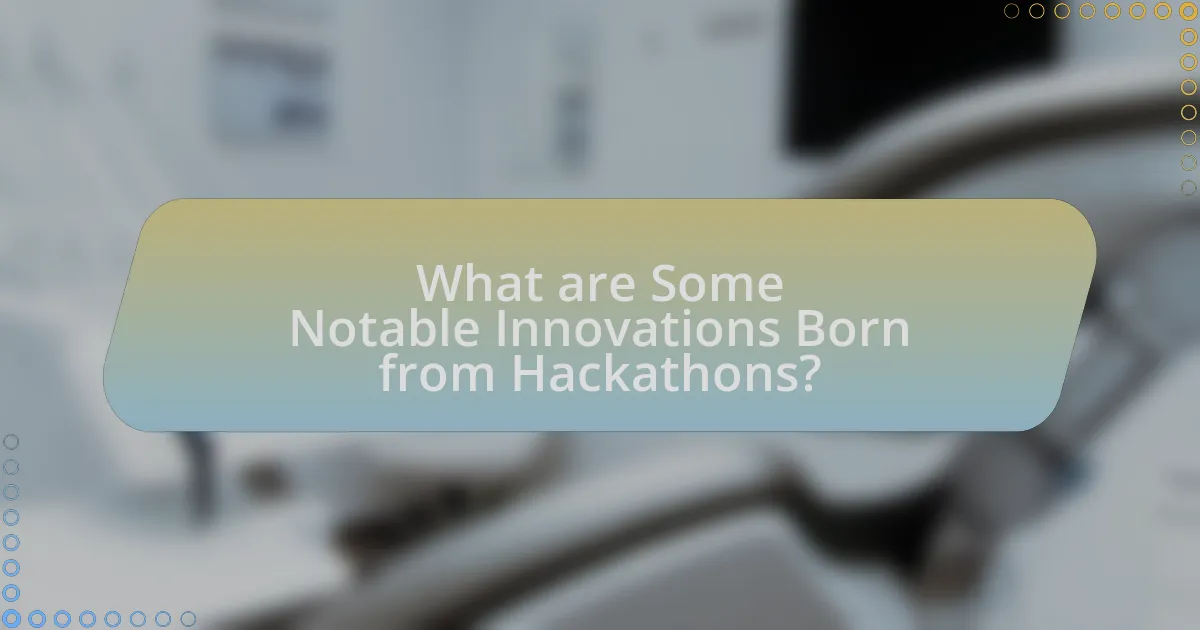
What are Some Notable Innovations Born from Hackathons?
Notable innovations born from hackathons include GroupMe, a group messaging app created during a hackathon at TechCrunch Disrupt in 2010, which was later acquired by Skype for $85 million. Another significant innovation is the mobile payment platform Venmo, which originated from a hackathon project in 2009 and was acquired by Braintree for $26 million in 2012. Additionally, the social media platform Instagram was initially developed as a hackathon project called Burbn before pivoting to its current form, ultimately leading to its acquisition by Facebook for $1 billion in 2012. These examples demonstrate how hackathons can foster creativity and lead to successful tech innovations.
How did specific Hackathons lead to successful products?
Specific hackathons have led to successful products by providing a structured environment for rapid prototyping and collaboration among diverse teams. For instance, the TechCrunch Disrupt Hackathon in 2011 resulted in the creation of GroupMe, a group messaging app that was later acquired by Skype for $85 million. This hackathon allowed developers to focus intensely on building a functional product within a limited timeframe, fostering innovation and creativity. Similarly, the Startup Weekend events have produced numerous successful startups, such as Foodspotting, which gained significant traction and was acquired by OpenTable. These examples demonstrate how hackathons serve as catalysts for turning ideas into viable products through teamwork, mentorship, and access to resources.
What was the process behind the creation of these innovations?
The process behind the creation of innovations from hackathons typically involves collaborative brainstorming, rapid prototyping, and iterative development. Participants form teams to identify specific problems or needs, then generate ideas and develop solutions within a limited timeframe, often 24 to 48 hours. This intense environment fosters creativity and encourages participants to leverage diverse skills and perspectives. For instance, the hackathon model has led to successful projects like GroupMe, which originated from a hackathon at TechCrunch Disrupt in 2010, demonstrating how structured collaboration can yield viable products.
What challenges did teams face during development?
Teams faced several challenges during development, including time constraints, resource limitations, and communication issues. Time constraints often resulted from the short duration of hackathons, which typically last 24 to 48 hours, forcing teams to prioritize features and make quick decisions. Resource limitations included access to technology, tools, and expertise, which could hinder the development process. Communication issues arose from team members having different backgrounds and skill sets, leading to misunderstandings and misalignment on project goals. These challenges are commonly reported in case studies of hackathon innovations, highlighting the need for effective planning and collaboration strategies to overcome them.
What are the Key Success Factors for Innovations from Hackathons?
The key success factors for innovations from hackathons include diverse team composition, clear problem statements, effective mentorship, and a supportive environment. Diverse teams bring varied perspectives and skills, enhancing creativity and problem-solving capabilities. Clear problem statements guide participants in focusing their efforts on specific challenges, increasing the likelihood of impactful solutions. Effective mentorship provides participants with guidance and expertise, facilitating the development of innovative ideas. A supportive environment encourages collaboration and risk-taking, which are essential for fostering innovation. These factors collectively contribute to the successful generation of innovative solutions during hackathons.
How does team diversity impact the outcome of Hackathon projects?
Team diversity significantly enhances the outcome of Hackathon projects by fostering a wider range of ideas and perspectives. Diverse teams, which include members from various backgrounds, experiences, and skill sets, are more likely to generate innovative solutions and creative approaches to problem-solving. Research indicates that diverse teams can outperform homogeneous ones by up to 35% in terms of innovation and creativity, as highlighted in a study published by McKinsey & Company. This study found that companies with higher diversity levels are more likely to achieve above-average profitability and value creation. Therefore, the inclusion of diverse team members in Hackathons not only enriches the brainstorming process but also leads to more effective and comprehensive project outcomes.
What role does mentorship play in the success of Hackathon innovations?
Mentorship plays a crucial role in the success of Hackathon innovations by providing guidance, expertise, and networking opportunities that enhance the development process. Experienced mentors can help teams refine their ideas, navigate technical challenges, and improve their project presentations, which significantly increases the likelihood of success. For instance, a study by the Harvard Business Review found that mentorship can lead to a 20% increase in project success rates in competitive environments like Hackathons. This support not only boosts the confidence of participants but also fosters a collaborative atmosphere that encourages creativity and innovation.
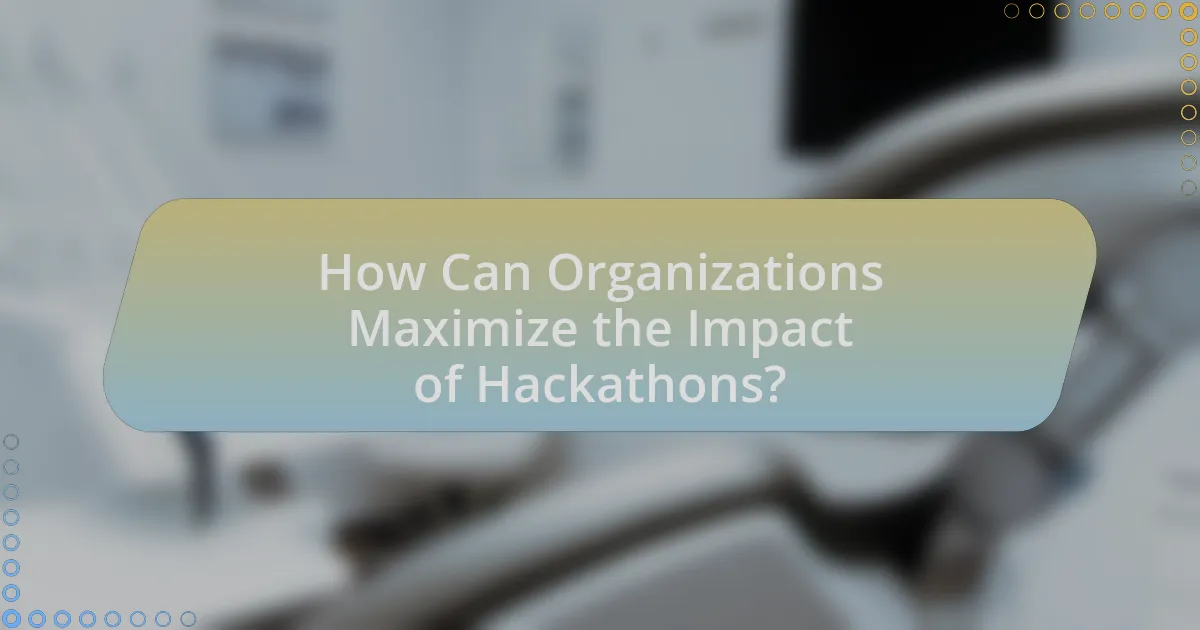
How Can Organizations Maximize the Impact of Hackathons?
Organizations can maximize the impact of hackathons by clearly defining objectives and aligning them with business goals. This strategic alignment ensures that the projects developed during the hackathon address real organizational challenges or opportunities. For instance, a study by the Harvard Business Review highlighted that companies that set specific goals for hackathons saw a 30% increase in actionable outcomes compared to those without defined objectives. Additionally, providing participants with access to relevant resources, mentorship, and follow-up support can enhance the quality of solutions generated. Research from the University of California found that hackathons with structured mentorship led to a 50% higher success rate in project implementation. By fostering a collaborative environment and encouraging diverse team compositions, organizations can further drive innovation and creativity, leading to impactful results.
What strategies can be employed to enhance Hackathon outcomes?
To enhance Hackathon outcomes, organizers should implement clear objectives, diverse team compositions, and structured mentorship. Clear objectives guide participants towards specific goals, increasing focus and productivity; for instance, Hackathons with defined themes often yield more relevant solutions. Diverse team compositions foster creativity and innovation, as varied perspectives lead to unique problem-solving approaches; studies show that teams with mixed skill sets outperform homogeneous groups. Structured mentorship provides participants with expert guidance, improving the quality of projects; research indicates that mentorship can significantly elevate the success rate of Hackathon projects by offering critical insights and support.
How can organizations effectively select themes for Hackathons?
Organizations can effectively select themes for Hackathons by aligning them with strategic goals, industry trends, and participant interests. This alignment ensures that the themes are relevant and can drive innovation that meets organizational needs. For instance, a study by the Harvard Business Review highlights that Hackathons focused on specific business challenges yield higher engagement and more actionable solutions. Additionally, organizations can gather input from potential participants through surveys or brainstorming sessions to identify themes that resonate with their skills and passions, further enhancing participation and creativity.
What are best practices for facilitating collaboration during Hackathons?
Best practices for facilitating collaboration during hackathons include establishing clear goals, promoting diverse team formation, and providing structured time for brainstorming and feedback. Clear goals ensure that all participants understand the objectives, which enhances focus and productivity. Diverse team formation brings together varied skill sets and perspectives, fostering creativity and innovation. Structured time for brainstorming and feedback allows teams to refine their ideas and solutions, leading to more effective outcomes. These practices are supported by research indicating that diverse teams outperform homogeneous ones in problem-solving scenarios, as highlighted in studies by the Harvard Business Review.
What are Common Pitfalls to Avoid in Hackathons?
Common pitfalls to avoid in hackathons include poor time management, lack of clear goals, and inadequate team communication. Poor time management often leads to rushed projects that fail to meet quality standards, as participants may underestimate the time required for development. Lack of clear goals can result in teams working on unrelated tasks, diluting focus and effort, which can hinder the overall success of the project. Inadequate team communication can create misunderstandings and misalignment, ultimately affecting collaboration and productivity. According to a study by the University of California, teams that establish clear objectives and maintain open lines of communication are 30% more likely to succeed in hackathon environments.
How can organizations ensure that Hackathons remain focused and productive?
Organizations can ensure that hackathons remain focused and productive by establishing clear objectives and guidelines before the event. Defining specific goals helps participants understand the desired outcomes, which can lead to more targeted efforts and innovative solutions. For instance, a study by the Harvard Business Review highlights that hackathons with well-defined themes or challenges yield higher-quality projects, as participants are more aligned with the event’s purpose. Additionally, providing structured time management and resources, such as mentorship and access to tools, further enhances productivity by keeping teams on track and minimizing distractions.
What measures can be taken to prevent burnout among participants?
To prevent burnout among participants in hackathons, organizers should implement structured breaks and promote a balanced workload. Research indicates that regular breaks enhance productivity and creativity, reducing stress levels. For instance, a study published in the Journal of Occupational Health Psychology found that taking short breaks during intense work periods can significantly lower fatigue and improve overall performance. Additionally, providing resources such as mental health support and encouraging a collaborative environment can further mitigate burnout risks. These measures create a healthier atmosphere, allowing participants to engage fully without overwhelming stress.
What are the Future Trends in Hackathons and Innovation?
Future trends in hackathons and innovation include increased focus on remote participation, integration of artificial intelligence, and collaboration with corporate sponsors. Remote participation allows a broader range of participants, enhancing diversity and creativity in solutions. The integration of artificial intelligence tools facilitates rapid prototyping and idea generation, streamlining the innovation process. Additionally, partnerships with corporate sponsors provide resources and mentorship, leading to more viable product development. These trends are supported by the rise of virtual hackathons, which saw a 50% increase in participation during the pandemic, demonstrating the effectiveness of remote engagement in fostering innovation.
How is technology evolving the Hackathon experience?
Technology is evolving the Hackathon experience by enhancing collaboration, accessibility, and innovation through digital tools and platforms. Online collaboration tools like GitHub and Slack facilitate real-time communication and project management, allowing participants to work together seamlessly regardless of location. Additionally, cloud computing services provide instant access to resources and APIs, enabling teams to prototype and develop solutions rapidly. The integration of artificial intelligence and machine learning tools further accelerates the ideation process, allowing participants to leverage advanced technologies in their projects. According to a report by the Global Hackathon Network, 70% of participants noted that technology significantly improved their ability to collaborate and innovate during events.
What emerging fields are likely to benefit from Hackathon innovations?
Emerging fields likely to benefit from Hackathon innovations include artificial intelligence, blockchain technology, and health tech. These areas are experiencing rapid growth and demand for innovative solutions. For instance, artificial intelligence is transforming industries by automating processes and enhancing decision-making, while blockchain technology is revolutionizing data security and transparency in transactions. Health tech is leveraging hackathon innovations to develop new medical devices and telehealth solutions, addressing urgent healthcare challenges. The collaborative and fast-paced environment of hackathons fosters creativity and problem-solving, making them ideal for generating impactful advancements in these fields.
What Practical Tips Can Enhance Participation in Hackathons?
To enhance participation in hackathons, organizers should focus on creating an inclusive and engaging environment. This can be achieved by offering diverse team formation options, such as allowing participants to form teams based on shared interests or skills, which fosters collaboration and creativity. Additionally, providing clear guidelines and resources, including access to mentors and workshops, can help participants feel more prepared and supported. Research indicates that hackathons with structured networking opportunities see a 30% increase in participant engagement, as individuals are more likely to connect and collaborate effectively.

